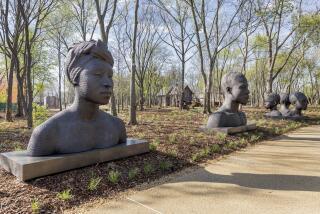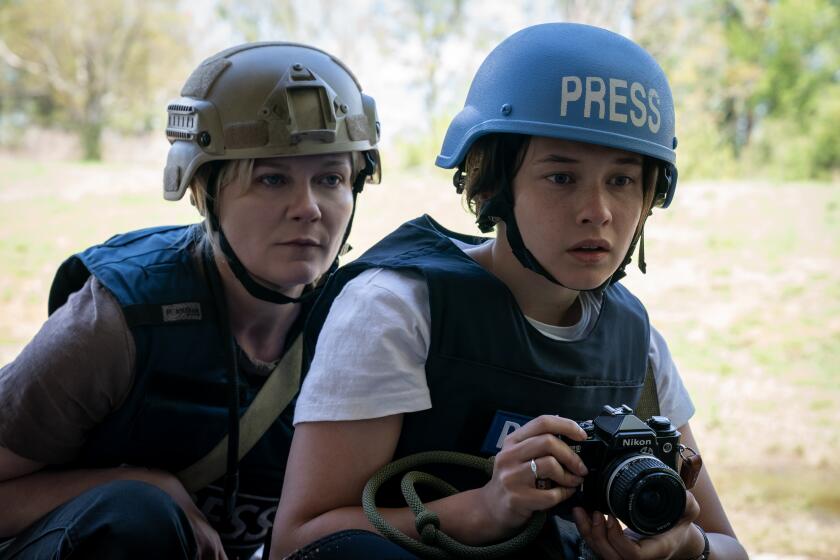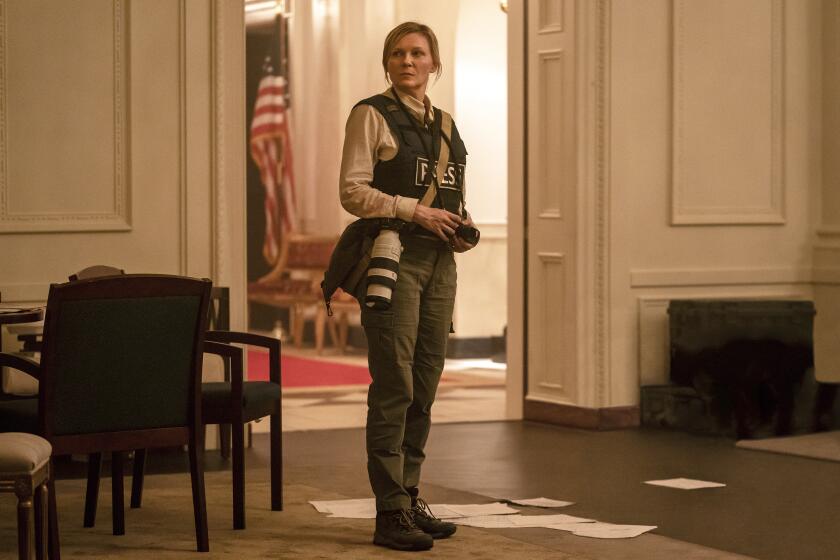Steve McQueen films ’12 Years a Slave’ on familiar territory
9 MILE POINT, La. — Director Steve McQueen was just a few yards from modern civilization — in this case, an air-conditioned sports utility vehicle that had brought him some 45 minutes from New Orleans — but as he looked around a sprawling plantation here last week, he could just as well have been walking around in the 1840s.
Spanish moss draped from the limbs of many of the sycamores, and the only way to navigate much of the 200-acre property was to plod down rough paths where the mud reached your shins. The plantation’s main residence dates to 1784, and because its land rests largely below levees, you could neither see nor hear the Mississippi River, even though the waterway was just a stone’s throw away. The mosquitoes were as thick as the buzzing of the cicadas.
“Oh, my God, look at this,” McQueen said as he turned a corner on the foot path, slapping at the bugs landing atop his head. “It’s all overgrown. The grass has all come back. It looks like the Hanging Gardens of Babylon.”
WATCH: Envelope Screening Series — ’12 Years a Slave’
A year ago in this precise spot — a small clearing with a giant live oak at its center — was where McQueen filmed a critical scene in “12 Years a Slave.” The movie, opening in limited release Friday, traces the true story of a free man named Solomon Northup living in New York who was drugged, kidnapped and sold into slavery in Louisiana for a dozen years.
The last time the British filmmaker behind “Shame” and “Hunger” was in this clearing, Solomon, played by Chiwetel Ejiofor, was desperate to return to his wife and children in the North and was about to make a run for it.
He had stepped into the clearing, where he promptly came upon two would-be runaways. They had been captured in the act of fleeing and were being strung up on nooses. Solomon quickly turned around, more certain than ever there was no flight from his predicament.
One owner of the plantation had told McQueen and his team that their selection of the specific tree was jarringly fitting. In the shadows of the huge tree, in ground swiftly disappearing under kudzu vines, were the graves of slaves who had been hanged from its branches in the 19th century. There were no headstones, but if you looked closely, you could make out several small mounds in the undergrowth.
REVIEW: ’12 Years a Slave’ impressive, and hard to watch
“It’s what made the scene even more vital and necessary — bringing the past into the present. If this tree had eyes, imagine what it has seen,” said McQueen, dressed in a maroon shirt, black jacket, navy pants and black boots. “Just out of respect, we said a few words before we started shooting here.”
As adapted by screenwriter John Ridley, “12 Years a Slave” follows Northup’s memoir of the same name, published in 1853 with the help of writer David Wilson, remarkably closely.
While Ridley compressed some scenes in the memoir’s earliest chapters, he didn’t have to invent any of the most horrific acts that befall Solomon in the film, including when he has to whip fellow slave Patsey (newcomer Lupita Nyong’o) on the orders of a sadistic plantation owner named Edwin Epps (Michael Fassbender). The film also stars Benedict Cumberbatch, Paul Dano, Paul Giamatti, Alfre Woodard, Sarah Paulson and Brad Pitt.
As part of the rigor of presenting Solomon’s story with scant embellishment, McQueen said he considered only one location for filming: Louisiana. It was a fortuitous coincidence that the state has some of the most generous film production credits in the nation, rebates that can cut as much as 35% from a movie’s cost, which kept the “12 Years a Slave” budget to a modest $22 million.
PHOTOS: ’12 Years a Slave,’ on location
“I couldn’t shoot anywhere else,” McQueen, who had never visited the state before making “12 Years a Slave,” said on the plantation near 9 Mile Point, a few hours before “12 Years a Slave” would open the New Orleans Film Festival.
The production traveled to four main plantations during filming, most of which were south of where the real-life Solomon was held and toiled, because journeys from New Orleans to more distant parcels would have been impractical and expensive. (That meant the film had to hire botanists to plant half an acre of cotton because the crop generally is farmed farther north in the state).
Cinematographer Sean Bobbitt, who has shot all three of McQueen’s features, said it wasn’t difficult to find plantations that would welcome such a production. But in many cases, the architectural artifacts of slavery — the huts where slaves slept, for example — had been removed. “Rather than repair them, they tore them down,” Bobbitt said. “So while the facades of the plantation homes have been preserved, a lot of the elements of slavery are gone.”
McQueen and the owner of the plantation with the hanging tree asked that the location not be identified in this article out of fear that vandals, motivated by whatever strong feelings they might hold about slavery, would cut the oak down.
PHOTOS: Scenes from ’12 Years a Slave’
Owing to scheduling constraints, “12 Years a Slave” had to be shot in the middle of the summer, and the temperatures often exceeded 100 degrees, with oppressive humidity.
“The heat is a character of its own,” Nyong’o said. “It changes the way you walk — it changes how you think. It definitely helped move me into character. I don’t think there’s any other place in the world we could have shot. It’s pregnant with history.”
When the movie was filming closer to swamps, the production brought in four snake and alligator wranglers to keep any unwelcome wildlife away from the cast and crew.
“It was a very hot summer and also a very wet summer. We had very extreme conditions,” said McQueen, dousing himself with bug spray. “But without the locations, we wouldn’t have the performances that we got. The fact of being on a plantation does something to you. It’s like being at the scene of the crime. And yet it’s also extraordinarily beautiful. It’s an odd thing to be around.”
VIDEO: ’12 Years a Slave’ trailer
Though the film’s subject matter is exceedingly rough, the loveliness of the land reinforced in McQueen and Bobbitt’s minds that “12 Years a Slave” should be filmed in a composed, painterly style, with several extended shots that look like a formal portrait — the still life of slaves. He said that if he and McQueen hadn’t shot the film in a lush style, audiences might find the film unrelentingly harsh.
“We spent a lot of time talking about things in broad strokes and coming up with early ideas. When you get to the locations, those broad strokes get tighter,” said Bobbitt, a former television news journalist. “When you see the locations, the story starts to come alive visually.”
Added McQueen, referring to an opening shot of slaves standing silently: “That tableaux is like the first day of school. You line up, not knowing what’s going to happen, and someone tells you what to do.”
Woodard, who in the film plays a former slave named Mistress Shaw who enjoys a privileged life because she has married a white slave owner, said she previously worked several times as an actor on plantations. The first time she did so, “it wrecked me,” Woodard said. Making McQueen’s movie, on the other hand, was almost a spiritual experience.
ON LOCATION: Where the cameras roll
“This was a lot more intense, because of the actual proximity,” Woodard said. “It becomes a place that’s sacred to you — but in the way of a family reunion that goes way, way back — because you own that land.”
Knowing that they were working so near to where Northup and thousands of other slaves had suffered so horribly didn’t just lend the production a sense of verisimilitude; the immediacy also deepened their commitment to tell his story as faultlessly as possible. At several points in the filming during emotionally and physically draining scenes, crew members either broke down in tears or had to avert their eyes.
“As actors, you want to slip down the rabbit hole,” Ejiofor said of shooting in Louisiana. “You want to get as close to the experience as you can possibly do.”
Back at the hanging tree, McQueen recalled how he had returned to the plantation months after wrapping principal photography, needing to reshoot the hanging scene because his initial filming of the sequence (at another location) hadn’t worked to his satisfaction for a variety of reasons.
“It wasn’t good enough. It needed something more,” McQueen said.
When he and Bobbitt first saw the giant oak, they considered it excessively large, its lower limbs too far from the ground. But once they learned of the graves beneath it, their minds were in agreement — here they would not only be filming but also reenacting.
“The scene was not connecting somehow,” McQueen said. “What we needed was something, and the something we needed was the tree. It brought everything back together.”
Times staff writer Amy Kaufman contributed to this report.
More to Read
Only good movies
Get the Indie Focus newsletter, Mark Olsen's weekly guide to the world of cinema.
You may occasionally receive promotional content from the Los Angeles Times.







